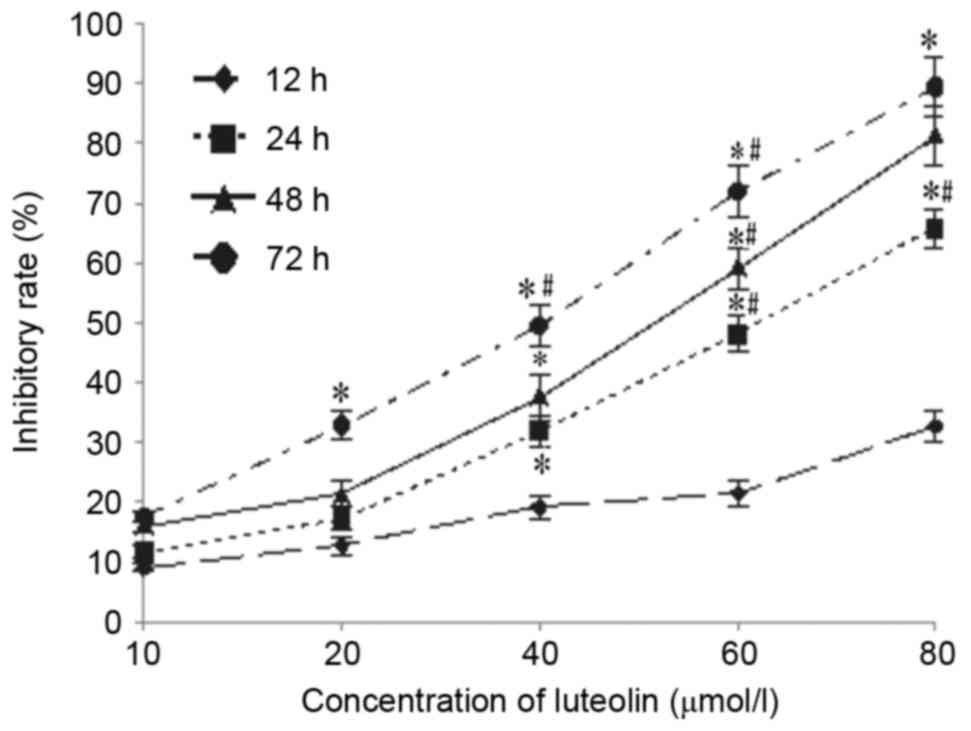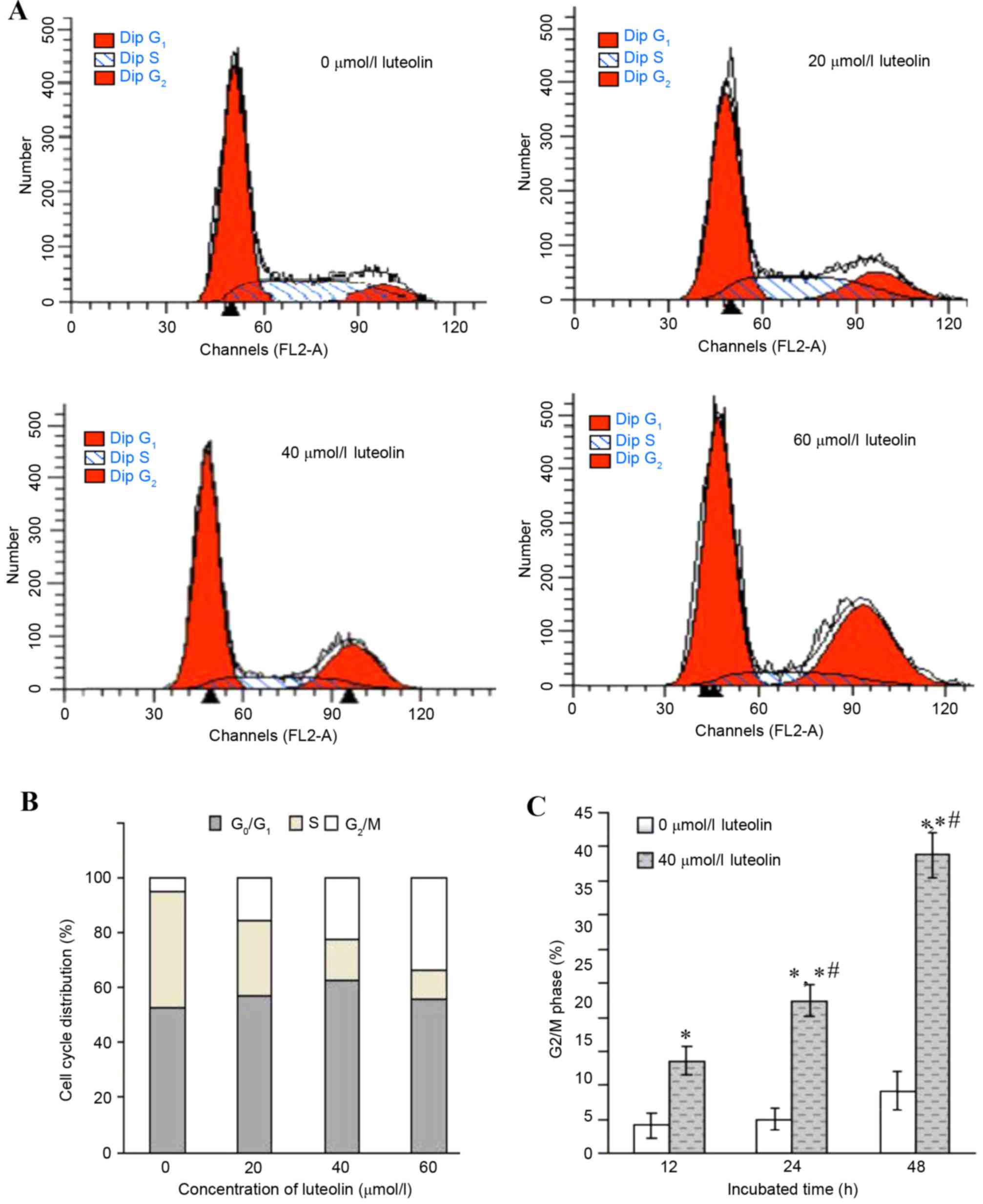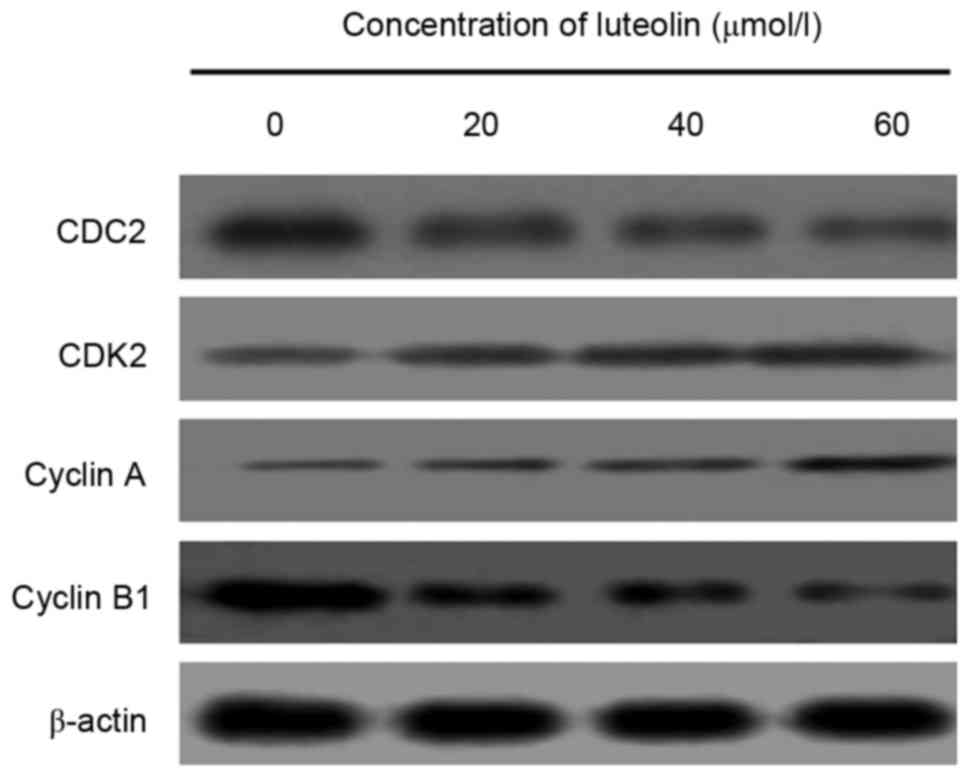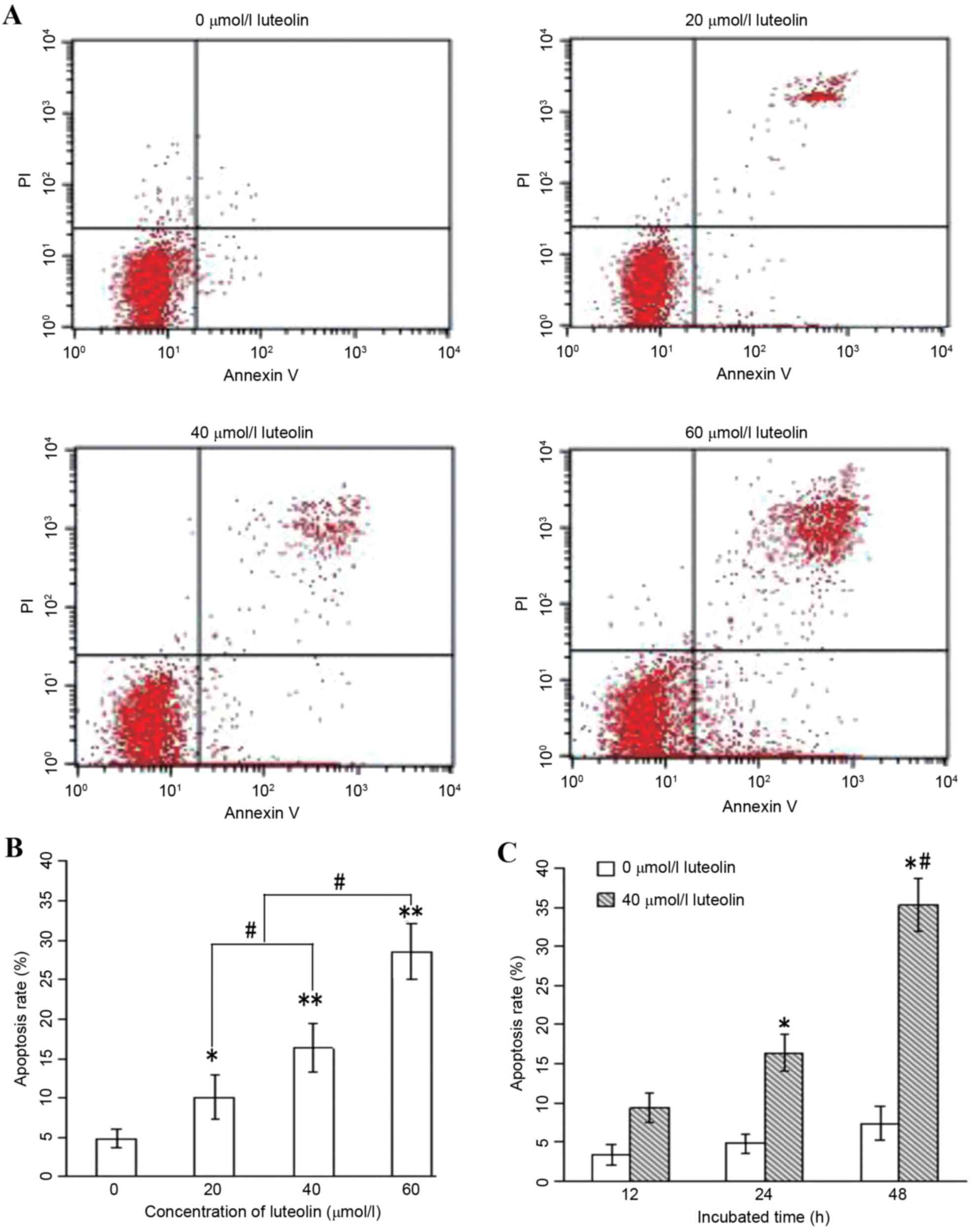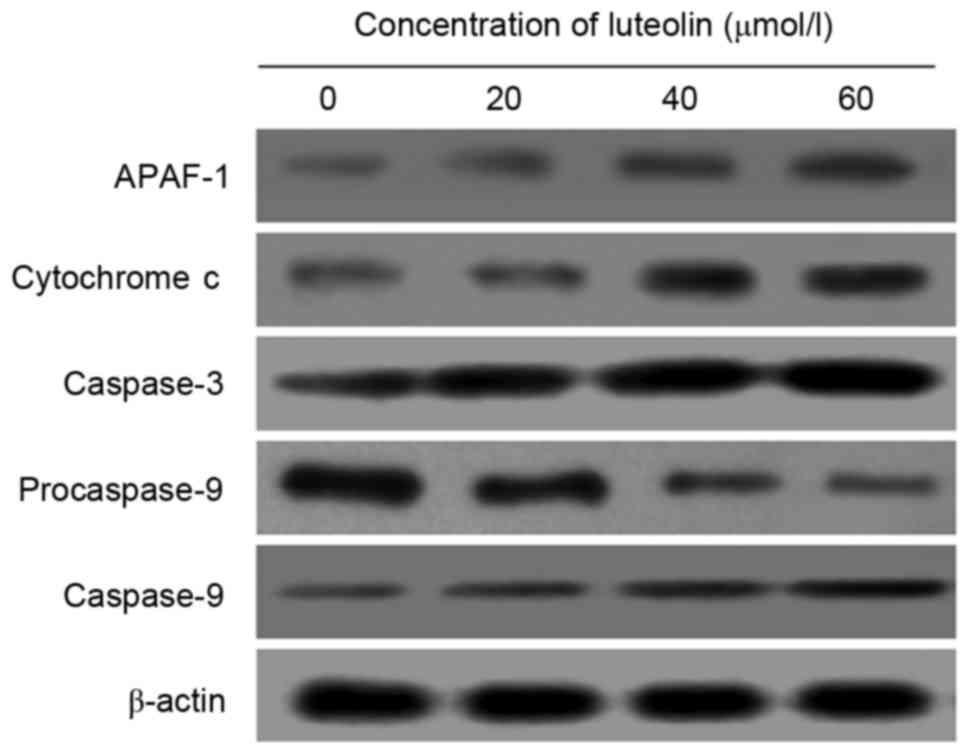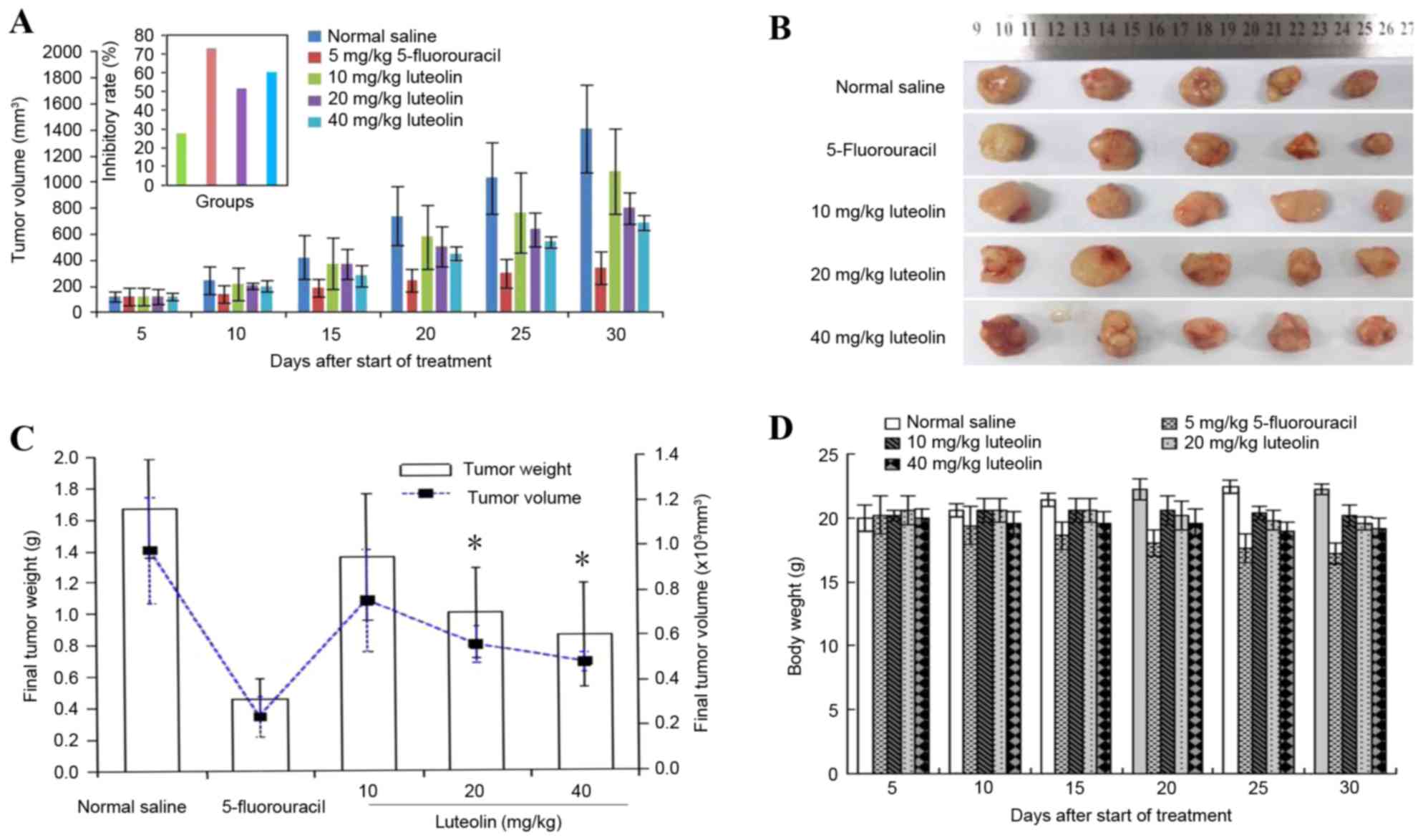Modulation of G2/M cell cycle arrest and apoptosis by luteolin in human colon cancer cells and xenografts
- Authors:
- Published online on: November 23, 2017 https://doi.org/10.3892/ol.2017.7475
- Pages: 1559-1565
-
Copyright: © Chen et al. This is an open access article distributed under the terms of Creative Commons Attribution License [CC BY_NC 4.0].
Abstract
Introduction
In previous decades, colon cancer has become one of the leading causes of cancer-associated mortality (1). Although traditional treatments including surgery, radiation therapy and chemotherapy have been improved (2), the evaluation and development of new effective agents or phytochemicals is still required to improve the survival rate.
With the development of natural medicinal chemistry and molecular biology, new antitumor substances obtained from traditional Chinese herbs are topics of much debate. In cellular studies, luteolin (3′,4′,5,7-tetrahydroxyflavone), a common constituent of flavone, identified in medicinal plants as well as specific vegetables and spices, has been reported to possess anti-inflammatory, antioxidant, anti-cancer and a number of other activities (3–5). It has been demonstrated in a previous study that luteolin delayed or blocked the development of cancer cells in vitro and in vivo by providing protection from carcinogenic stimuli, owing to inhibition of tumor cell proliferation, induction of cell cycle arrest and induction of apoptosis via intrinsic and extrinsic signaling pathways (6). However, the underlying mechanism of the effects of luteolin on human colon cancer cells has not been previously addressed. In the present study, LoVo cells were therefore used as an appropriate model to evaluate the activity of luteolin against human colon cancer using in vitro and in vivo systems, and to provide further information regarding the molecular mechanism of luteolin-mediated apoptosis and cell cycle modulation. The results from the present study suggest that luteolin may be a potential agent for the prevention and treatment of human colon cancer.
Materials and methods
Main reagents
Luteolin was purchased from Sigma-Aldrich (EMD Millipore, Billerica, MA, USA); and was dissolved in dimethyl sulphoxide and its concentration was adjusted to 100 mmol/l, as a stock solution. The Cell Counting kit-8 was supplied by Beyotime Institute of Biotechnology (Haimen, China). Annexin V-fluorescein isothiocyanate (FITC) apoptosis and cell cycle detection kits were obtained from BD Biosciences (Franklin Lakes, NJ, USA). A bicinchoninic acid protein assay kit was purchased from Biosynthesis Biotechnology Co., Ltd. (Beijing, China) and monoclonal antibodies, including rabbit anti-human cell division cycle 2 (CDC2), cyclin-dependent kinase 2 (CDK2), cyclin B1, cyclin A, apoptotic protease activating factor 1 (APAF-1), cytochrome c, caspase-3, mouse anti-human procaspase-9, mouse anti-human caspase-9 and mouse anti-human β-actin, were purchased from Cell Signaling Technology, Inc. (Danvers, MA, USA).
Cell line and cell culture
The human colon cancer cell line, LoVo, was obtained from the Institute of Biochemistry and Cell Biology, Shanghai Institutes for Biological Sciences, Chinese Academy of Sciences (Shanghai, China). The cells were cultured in Dulbecco's modified Eagle's medium supplemented with 10% (v/v) fetal calf serum, 100 U/ml penicillin, 100 µg/ml streptomycin and 1 mmol/l HEPES buffer (Beijing Solarbio Science & Technology Co., Ltd., Beijing, China) at 37°C in humidified air containing 5% CO2 until they reached ~80% confluency, and the cells were used in subsequent experiments.
Cell counting kit-8 (CCK8) assay
LoVo cells were trypsinized and plated at 4×103 cells/well in 96-well plates. Following incubation for 24 h, various concentrations of luteolin (0, 10, 20, 40, 60 and 80 µmol/l) were added and cells were incubated for 12, 24, 48 and 72 h, respectively. Next, 10 µl CCK8 solution (5 g/l) in phosphate-buffered saline (PBS) was added to each well. Following incubation for an additional 3 h, the optical density for each well was measured using a microculture plate reader (BioTek Instruments, Inc., Winooski, VT, USA) at a wavelength of 450 nm.
Cell cycle analysis
A total of 4×105 LoVo cells per well were seeded in six-well plates for 24 h at 37°C. The cells were washed, replaced with fresh medium and subsequently incubated with various doses of luteolin (0, 20, 40 and 60 µmol/l) for 12, 24 and 48 h. The cells were then trypsinized, washed with PBS and stained with 50 µg/ml cold propidium iodide (PI) solution containing 0.1 mg/ml RNase A in PBS (pH 7.4) for 30 min in the dark at room temperature. Thereafter, cell cycle data analysis was performed using a FACSCalibur flow cytometer with CellQuest V.3.3 software (Becton-Dickinson; BD Biosciences, Franklin Lakes, NJ, USA).
Flow cytometric apoptosis assay
Following incubation with 0, 20, 40 and 60 µmol/l luteolin for either 24 or 48 h. A total of 1×105 LoVo cells were harvested, washed and resuspended with PBS. Apoptotic cells were then identified using the FACSCalibur flow cytometer (Becton-Dickinson) according to the manufacturer's protocol. Briefly, the cells were washed and subsequently incubated for 15 min at room temperature in the dark in 100 µl 1X binding buffer containing 5 µl Annexin V-FITC and 5 µl PI. Thereafter, the total apoptosis rate was examined by flow cytometry.
Western blot analysis
Western blot analysis was performed as described previously (7). Briefly, aliquots of cell lysates containing 25 µg protein were separated by sodium dodecyl sulfate polyacrylamide gel electrophoresis. Then, electrophoresed proteins were transferred onto nitrocellulose membranes and detected with specific primary and secondary antibodies. Thereafter, the blots were visualized using an enhanced chemiluminescence system (GE Healthcare Life Sciences, Little Chalfont, UK), and the density of β-actin served as an internal loading control.
Establishment and treatment of human colon cancer xenografts
Six-week old BALB/C nude mice (18–22 g) were obtained from Shanghai National Center for Laboratory Animals (Shanghai, China). In the present study the nude mice, which were fed with sterilized food and water ad libitum, were maintained at a temperature of 22°C and a humidity environment approximately 40–50% with a light-dark cycle of 12:12 h. All research procedures carried out in the present study were approved by the Medical Ethics Committee of Southeast University (Nanjing, China).
To assess the effect of luteolin on tumorigenicity, BALB/C nude mice were inoculated with LoVo cells for formatting LoVo colon cancer xenografts. In brief, 30 nude mice were inoculated subcutaneously into the flank with 100 ml exponentially growing LoVo cells at a concentration of 5×106 cells/ml, and allowed to proliferate for ~1 week. When the tumor volume of mice reached ~100 mm3, they were randomly divided into five groups with six mice in each group. Three of these groups were administered 10, 20 or 40 mg/kg luteolin intraperitoneally on alternate days for a month. The other groups were administered either normal saline or 15 mg/kg 5-fluorouracil (5-FU) intraperitoneally as controls. During the whole experimental period, the feed intake and motor activity of mice were carefully observed, their body weights were measured, and the tumor volumes were calculated every 5 days using the following formula: Tumor volume (mm3)=(1/2)xaxb2, where a is the largest diameter (length) and b is the smallest diameter (width) of the tumor. At the end of the experiments, the mice were sacrificed, the excised primary tumor mass was weighed and the tumor volume was calculated. Thereafter, the relative tumor volume (RTV) was calculated as RTV=Vday X/Vfirst day, and the inhibitory rate was calculated using the formula: Inhibitory rate (%)=(1-RTVexperimental group/RTVcontrol group)×100.
Statistical analysis
All data are expressed as the means ± standard deviation for experiments performed in triplicate, and the data were analyzed using the Statistical Package for the Social Sciences (SPSS version 18.0; SPSS Inc., Chicago, IL, USA). Comparisons between two groups were performed with unpaired Student's t-test and those between three or more groups were done using one way analysis of variance followed by the Student-Newman-Keuls test. P<0.05 was considered to indicate a statistically significant difference.
Results
Effects of luteolin on growth of LoVo cells
The growth inhibitory potential of luteolin was determined in cultured LoVo cells by CCK8 assay at various intervals (12, 24, 48 and 72 h) of treatment. As a result, luteolin exhibited a significant growth inhibitory effect against LoVo cells, and the concentration of luteolin required to yield a 50% inhibitory concentration (IC50) of the proliferation, as measured at the 24, 48 and 72 h time points, was 66.70, 41.49 and 30.47 µmol/l, respectively (Fig. 1). Therefore, these results demonstrated that luteolin inhibited the proliferation of LoVo cells significantly in a time- and dose-dependent manner.
Effect of luteolin on cell cycle in colon tumor cells
The inhibition of cell proliferation may be a result of the induction of apoptosis, which may be mediated by cell cycle arrest. Therefore, the cell cycle distribution in the LoVo cells treated with luteolin was further analyzed for various times. An increased percentage of cells in the G2/M phase together with a decrease in the S phase was observed to occur in a dose-dependent manner (Fig. 2A and B), while the percentages of G0/G1 phase cells remained at almost the same levels. When exposed to 40 µmol/l luteolin for various times, the cell population of LoVo cells in the G2/M phase was 13.62±2.15% at 12 h, 22.35±2.43% at 24 h and 43.76±3.21% at 48 h, respectively, and there were significant differences compared with the control group (Fig. 2C; 5.07±1.64%; P<0.05).
To investigate the apoptotic mechanisms through which luteolin interferes with cell cycle progression, the expression of cell cycle-associated proteins was measured following treatment with various concentrations of luteolin for 48 h. The measurement of cell cycle-associated protein markers revealed that the protein expression levels of CDC2 and cyclin B, which regulate G2/M transition in luteolin-treated LoVo cells, were downregulated, whereas those of cyclin A and CDK2 were upregulated in a dose-dependent manner (Fig. 3).
Effect of luteolin on apoptotic death in colon cancer cells
Annexin V/PI analysis was applied to quantify the percentage of cells undergoing apoptosis. Following treatment with luteolin for 24 h, the total percentages of cells undergoing early (Annexin-positive/PI-negative) and late (Annexin-positive/PI-positive) apoptosis were measured, and the results are shown in Fig. 4A and B. These results indicate that luteolin induced apoptosis in the LoVo cells in a dose-dependent manner. Furthermore, when the LoVo cells were incubated with 40 µmol/l luteolin for 12, 24 and 48 h, the apoptotic rate increased significantly with the prolonged duration of the experiment (Fig. 4C; P<0.05).
To explore the molecular mechanisms of luteolin on apoptotic proteins, Western blot analysis was conducted to evaluate the expression of APAF-1, cytochrome c, procaspase-9, caspase-9 and caspase-3 proteins. Following treatment with luteolin for 48 h, a significant decrease of procaspase-9 in LoVo cells was observed in the groups treated with 20, 40 and 60 µmol/l luteolin compared with the control group (P<0.05). By contrast, the protein expression of APAF-1, cytochrome c, caspase-9 and caspase-3 was significantly increased compared with the control group (Fig. 5).
Effect of luteolin on tumorigenicity in vivo
The incidence of subcutaneous tumors derived from LoVo cells was 100%. Luteolin inhibited tumor growth in a dose- and time-dependent manner (Fig. 6A and B). On the final day of the experiment, the excised primary tumor mass was 0.32±0.09 g for 15 mg/kg 5-FU, 0.70±0.20 g for 20 mg/kg luteolin, and 0.60±0.23 g for 40 mg/kg luteolin, which was lower than that of the control group (1.17±0.29 g). Similar results were obtained for the tumor volume, as shown in Fig. 6C, but there was no significant difference between the group receiving a low dose of luteolin (10 mg/kg) and the control group (0.95±0.45 g vs. 1.17±0.29 g, and 1405.8±574.84 mm3 vs. 1081.39±794.58 mm3). The tumor inhibition rate was 72.60% in the 5-FU group, 51.28% in the 20 mg/kg luteolin group and 59.83% in the 40 mg/kg luteolin group, which was higher than that in the 10 mg/kg luteolin group (27.35%; P<0.05). In addition, mice treated with 20 and 40 mg/kg luteolin consumed slightly more food than those in the control group, but there was no mortality or significant change in mice body weight observed throughout the experimental period in the control group or luteolin-treated groups (Fig. 6D). These results suggest that luteolin treatment significantly decreases colon tumor size and tumor weight without having a significant effect on the food intake or total body weight of the mice.
Discussion
Cancer is a multistep process that typically occurs over an extended period of time, beginning with initiation followed by promotion and progression (8). Recently, there have been concentrated efforts to develop novel dietary substances as cancer preventive and/or therapeutic agents (9). Understanding how these natural and synthetic compounds inhibit cell proliferation and cell survival may play a critical role in the development of new agents that prevent and treat cancer with low toxicity.
A growing body of evidence suggests that a number of herbal medicines provide a significant curative effect by inhibiting tumor cell proliferation and inducing apoptosis in tumor cells (7,10,11). As with numerous other flavonoids, luteolin is capable of inhibiting the proliferation of cancer cells, inducing tumor cell apoptosis and influencing tumor cell cycle distribution, as well as inhibiting the formation of new blood vessels in tumors. In the present study, the results of CCK8 assay demonstrated that luteolin exerted significant cytotoxicity on LoVo cells, and that the concentration of luteolin required to yield IC50 of the proliferation decreased with the prolonged incubation time. Therefore, the results demonstrate that luteolin significantly inhibited the proliferation of LoVo cells in a time- and dose-dependent manner. Similar observations have also been made in human colon carcinoma HCT-15 cells (12). Notably, it has been reported that there was no significant cytotoxicity in luteolin-treated normal human peripheral blood mononuclear cells (13). Despite previous findings that the decrease in cell proliferation and cell viability following treatment with luteolin may be associated with the effect of cell cycle arrest and/or the induction of apoptosis (14), the molecular mechanisms remain elusive. In the present study, the LoVo cell line was used as a model to provide in vitro evidence that luteolin induced G2/M phase arrest of cell cycle progression and apoptotic cell death, thus demonstrating the effect of luteolin on the decrease of cell viability and induction of cell death.
It is known that cell cycle check points and apoptosis play critical roles in the molecular pathogenesis of cancer, and influence the outcome of chemotherapy and radiotherapy (8). In the present study, an increased percentage of cells in the G2/M phase together with a decrease in S-phase cells was observed to occur in a dose- and time-dependent manner, while the percentages of G0/G1 phase cells remained at almost the same levels in the colon cancer cells. These results clearly confirm the effect of luteolin on the induction of G2/M cell cycle arrest in colon cancer cells, and these results are supported by other published studies using several other types of human colon cancer cells, including HCT-15 cells (4,12). Evidence in the literature suggests that cycle progression is controlled by several CDKs and their cyclin partners. Among the CDKs that regulate cell cycle progression, CDK1 and CDK2 are activated primarily in association with cyclin A and cyclin B in the cell division cycle (15–17). It is also worth noting that a key regulator of the G2/M transition of the cell cycle is a complex of CDC1/CDK2 and a B-type cyclin (18). If CDC1/CDK2 were inhibited, one would expect an arrest at the G2/M transition. In the present study, the protein expression levels of CDC2 and cyclin B were downregulated, whereas those of cyclin A and CDK2 were upregulated in a dose-dependent manner in luteolin-treated LoVo cells. In a previous study, Lim et al (4) demonstrated that luteolin-mediated negative regulation of CDC2 contributed to increasing G2/M arrest. Taken together, these results demonstrate that treatment of luteolin triggers a dose-dependent accumulation of G2/M phase colon cancer cells through the inactivation of cyclin B1/CDC2.
Based on its relevant effects on cell growth and cell cycle progression, there was a need to examine whether luteolin was capable of inducing apoptosis in LoVo cells. Annexin V/PI analysis was applied to quantify the percentage of cells undergoing apoptosis. Following treatment with luteolin for 24 h, the total percentages of cells undergoing early and late apoptosis indicated that luteolin induced apoptosis in the LoVo cells in a dose-dependent manner. Furthermore, the apoptotic rate increased significantly with the prolonged duration of the experiment. These results indicate that the induction of apoptosis by luteolin is involved in its antitumor activity. It is known that APAF-1 contains a caspase recruitment domain (CARD) at the N terminus, a nucleotide-binding domain, a helical domain, a winged helix domain, a second helical domain and 15 WD40 repeats at the C-terminal half (19), and exerts a critical role in apoptosis. Upon binding to cytochrome c and deoxyadenosine triphosphate (dATP), APAF-1 ‘calls’ caspase-9 through its CARD domain to form apoptotic bodies, activates caspase-3 and initiates the caspase cascade reaction, thereby leading to apoptosis (20). Thus, in the present study, the expression of certain key apoptotic proteins was assayed to investigate the possible mechanism of luteolin-induced apoptosis. A significant decrease of procaspase-9 in LoVo cells was observed with the increase of luteolin. By contrast, the protein expression of APAF-1, cytochrome c, caspase-9 and caspase-3 increased significantly compared with the control group. The results of the present study are consistent with those of a previous in vitro study demonstrating that apoptosis induction of luteolin was a significant cellular mechanism in inhibiting cell proliferation in various cancer types (3,14). These results further demonstrate that induction of luteolin on apoptosis of LoVo cells may be achieved by the molecular mechanism of the cytochrome c- and dATP-mediated activation of APAF-1.
To confirm the above inhibitory effect of luteolin on human colon cancer cells in culture, an in vivo study was conducted by transplanting human colon carcinoma cells into BALB/C nude mice. The effects of luteolin were assessed by measuring changes in the tumor volumes over a one-month treatment period. Supporting the in vitro results, in vivo experiments in nude mice with xenografted tumors revealed that luteolin suppressed the growth of tumors formed from human colon carcinoma cells in a dose- and time-dependent manner (Fig. 6A). Luteolin also significantly decreased the colon tumor size and tumor weight on the final day of the experiment. The present results are consistent with those of previous studies demonstrating that luteolin inhibited tumor growth and angiogenesis in xenografted tumors (21). In addition, BALB/C nude mice treated with 20 and 40 mg/kg luteolin consumed slightly more food than those in the control group, but there was no mortality or significant changes in mouse body weight observed during the experimental period in either the control group or the luteolin-treated groups, suggesting that the dose of luteolin used in the present study was well tolerated by the BALB/C nude mice. Additionally, other studies have demonstrated that luteolin may be administered orally or topically without any adverse effects on xenografts (22,23), and that it demonstrates potential cancer preventative effects (24). These results imply that luteolin is relatively safe when used as an anticancer agent.
In summary, the present study provides evidence that the inhibition of tumor growth by luteolin is significantly associated with cell cycle arrest at the G2/M phase transition with the inactivation of cyclin B1/CDC2 and cell apoptosis in part via the cytochrome c- and dATP-mediated activation of APAF-1. These findings provide a relevant basis for developing luteolin as a potential chemopreventive and chemotherapeutic agent against human colon cancer.
Acknowledgements
The present study was supported by a grant from the Natural Science Foundation of China (grant no. 81372985).
References
|
Cunningham D, Atkin W, Lenz HJ, Lynch HT, Minsky B, Nordlinger B and Starling N: Colorectal cancer. Lancet. 375:1030–1047. 2010. View Article : Google Scholar : PubMed/NCBI | |
|
Chang HF and Yang LL: Gamma-Mangostin, a micronutrient of mangosteen fruit, induces apoptosis in human colon cancer cells. Molecules. 17:8010–8021. 2012. View Article : Google Scholar : PubMed/NCBI | |
|
Xu T, Li D and Jiang D: Targeting cell signaling and apoptotic pathways by luteolin: Cardioprotective role in rat cardiomyocytes following ischemia/reperfusion. Nutrients. 4:2008–2019. 2012. View Article : Google Scholar : PubMed/NCBI | |
|
Lim DY, Jeong Y, Tyner AL and Park JH: Induction of cell cycle arrest and apoptosis in HT-29 human colon cancer cells by the dietary compound luteolin. Am J Physiol Gastrointest Liver Physiol. 292:G66–G75. 2007. View Article : Google Scholar : PubMed/NCBI | |
|
Xavier CP, Lima CF, Preto A, Seruca R, Fernandes-Ferreira M and Pereira-Wilson C: Luteolin, quercetin and ursolic acid are potent inhibitors of proliferation and inducers of apoptosis in both KRAS and BRAF mutated human colorectal cancer cells. Cancer Lett. 281:162–170. 2009. View Article : Google Scholar : PubMed/NCBI | |
|
Seelinger G, Merfort I, Wölfle U and Schempp CM: Anti-carcinogenic effects of the flavonoid luteolin. Molecules. 13:2628–2651. 2008. View Article : Google Scholar : PubMed/NCBI | |
|
Lu H, Gao F, Shu G, Xia G, Shao Z, Lu H and Cheng K: Wogonin inhibits the proliferation of myelodysplastic syndrome cells through the induction of cell cycle arrest and apoptosis. Mol Med Rep. 12:7285–7292. 2015. View Article : Google Scholar : PubMed/NCBI | |
|
Pandurangan AK, Dharmalingam P, Sadagopan SK, Ramar M, Munusamy A and Ganapasam S: Luteolin induces growth arrest in colon cancer cells through involvement of Wnt/β-catenin/GSK-3β signaling. J Environ Pathol Toxicol Oncol. 32:131–139. 2013. View Article : Google Scholar : PubMed/NCBI | |
|
Suh Y, Afaq F, Johnson JJ and Mukhtar H: A plant flavonoid fisetin induces apoptosis in colon cancer cells by inhibition of COX2 and Wnt/EGFR/NF-kappaB-signaling pathways. Carcinogenesis. 30:300–307. 2009. View Article : Google Scholar : PubMed/NCBI | |
|
Turktekin M, Konac E, Onen HI, Alp E, Yilmaz A and Menevse S: Evaluation of the effects of the flavonoid apigenin on apoptotic pathway gene expression on the colon cancer cell line (HT29). J Med Food. 14:1107–1117. 2011. View Article : Google Scholar : PubMed/NCBI | |
|
Li Y, Gong Y, Li L, Abdolmaleky HM and Zhou JR: Bioactive tanshinone I inhibits the growth of lung cancer in part via downregulation of aurora a function. Mol Carcinog. 52:535–543. 2013. View Article : Google Scholar : PubMed/NCBI | |
|
Sulaiman GM: In vitro study of molecular structure and cytotoxicity effect of luteolin in the human colon carcinoma cells. Eur Food Res Technol. 241:83–90. 2015. View Article : Google Scholar | |
|
Horinaka M, Yoshida T, Shiraishi T, Nakata S, Wakada M, Nakanishi R, Nishino H, Matsui H and Sakai T: Luteolin induces apoptosis via death receptor 5 upregulation in human malignant tumor cells. Oncogene. 24:7180–7189. 2005. View Article : Google Scholar : PubMed/NCBI | |
|
Cai X, Ye T, Liu C, Lu W, Lu M, Zhang J, Wang M and Cao P: Luteolin induced G2 phase cell cycle arrest and apoptosis on non-small cell lung cancer cells. Toxicol In Vitro. 25:1385–1391. 2011. View Article : Google Scholar : PubMed/NCBI | |
|
Krasinska L, Cot E and Fisher D: Selective chemical inhibition as a tool to study Cdk1 and Cdk2 functions in the cell cycle. Cell Cycle. 7:1702–1708. 2008. View Article : Google Scholar : PubMed/NCBI | |
|
Malumbres M and Barbacid M: Cell cycle, CDKs and cancer: A changing paradigm. Nat Rev Cancer. 9:153–166. 2009. View Article : Google Scholar : PubMed/NCBI | |
|
Canavese M, Santo L and Raje N: Cyclin dependent kinases in cancer: Potential for therapeutic intervention. Cancer Biol Ther. 13:451–457. 2012. View Article : Google Scholar : PubMed/NCBI | |
|
Nigg EA: Cyclin-dependent protein kinases: Key regulators of the eukaryotic cell cycle. Bioessays. 17:471–480. 1995. View Article : Google Scholar : PubMed/NCBI | |
|
Zhou M, Li Y, Hu Q, Bai XC, Huang W, Yan C, Scheres SH and Shi Y: Atomic structure of the apoptosome: Mechanism of cytochrome c- and dATP-mediated activation of Apaf-1. Genes Dev. 29:2349–2361. 2015. View Article : Google Scholar : PubMed/NCBI | |
|
Sun KW, Ma YY, Guan TP, Xia YJ, Shao CM, Chen LG, Ren YJ, Yao HB, Yang Q and He XJ: Oridonin induces apoptosis in gastric cancer through Apaf-1, cytochrome c and caspase-3 signaling pathway. World J Gastroenterol. 18:7166–7174. 2012. View Article : Google Scholar : PubMed/NCBI | |
|
Bagli E, Stefaniotou M, Morbidelli L, Ziche M, Psillas K, Murphy C and Fotsis T: Luteolin inhibits vascular endothelial growth factor-induced angiogenesis; inhibition of endothelial cell survival and proliferation by targeting phosphatidylinositol 3′-kinase activity. Cancer Res. 64:7936–7946. 2004. View Article : Google Scholar : PubMed/NCBI | |
|
Ueda H, Yamazaki C and Yamazaki M: Inhibitory effect of perilla leaf extract and luteolin on mouse skin tumor promotion. Biol Pharm Bull. 26:560–563. 2003. View Article : Google Scholar : PubMed/NCBI | |
|
Chiu FL and Lin JK: Downregulation of androgen receptor expression by luteolin causes inhibition of cell proliferation and induction of apoptosis in human prostate cancer cells and xenografts. Prostate. 68:61–71. 2008. View Article : Google Scholar : PubMed/NCBI | |
|
Lin Y, Shi RX, Wang X and Shen HM: Luteolin, a flavonoid with potential for cancer prevention and therapy. Curr Cancer Drug Targets. 8:634–646. 2008. View Article : Google Scholar : PubMed/NCBI |



